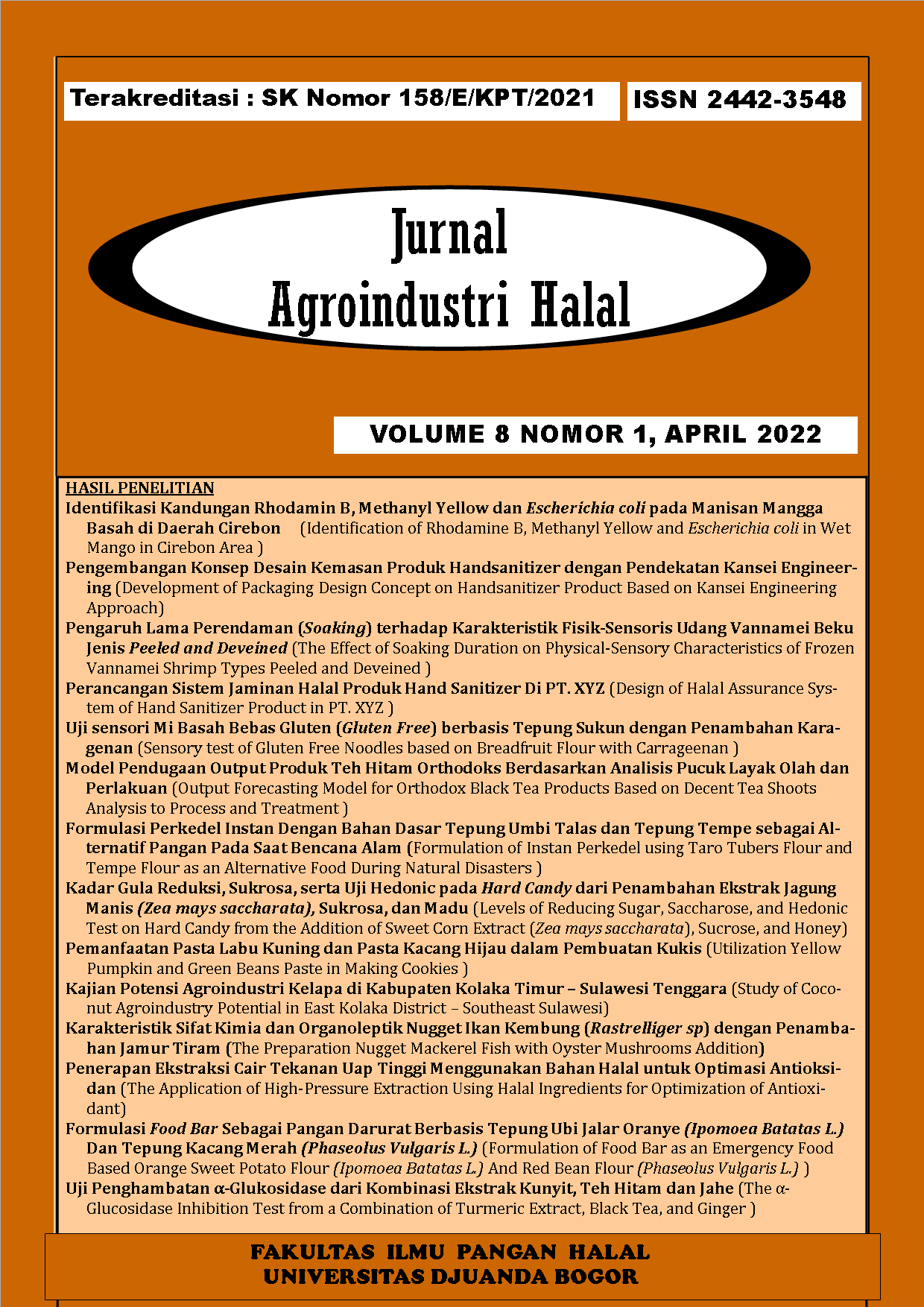Uji sensori Mi Basah Bebas Gluten (Gluten Free) berbasis Tepung Sukun dengan Penambahan Karagenan
DOI:
https://doi.org/10.30997/jah.v8i1.4759Keywords:
breadfruit ,gluten free, noodles , sensory testAbstract
Breadfruit is one of the alternative sources of new carbohydrates in the form of wet noodles. Breadfruit flour is a gluten-free food product, which is good for digestion and also for children with autism. Carrageenan is added to the manufacture of noodles as a substitute for gluten in the dough. To add color and taste, squid ink is added as a natural dye for breadfruit noodles. This study aims to determine consumer acceptance of breadfruit flour-based wet noodles with the addition of carrageenan as a thickener and squid ink as a dye. This study used a completely randomized design (CRD) with five treatments, namely with the addition of carrageenan 1%, 3%, 4%, 5% and without the addition of carrageenan (0%). Based on the results of the study, it was found that the water content of breadfruit flour was 2.86%, ash content was o, 2% and protein content was 6.35%. Based on the sensory test, it was found that the P value > 0.05 on all parameters, namely color, taste, aroma and texture, which means that the difference in carrageenan concentrations is not significantly different. The most preferred color by panelists on noodles with the addition of 7% carrageenan. The most preferred taste in breadfruit noodles without the addition of carrageenan and 5%. The most preferred aroma in noodles with the addition of 5% carrageenan. The most preferred texture in noodles with the addition of 1% carrageenan.
References
Biyumna, U. L., Windrati, W. S., & Diniyah, N. (2017). Karakteristik Mie Kering terbuat dari Tepung Sukun (Artocarpus altilis) dan Penambahan Telur. Jurnal Agroteknologi, 11(1), 23. doi: 10.19184/j-agt.v11i1.5440.
Listyawati, F. D. (2019). Karakteristik Mie Merah Gluten Free dari Tepung Gadung (Dioscorea hispida Dennst) dan Tepung Mocaf dengan Penambahan Gliserol. Jurnal Teknologi Dan Industri Pangan, 3(2), 135–143. doi: 10.33061/jitipari.v3i2.2696.
Hasmawati, Mustarin A., & Ratnawati, F. (2020). Analisis Kualitas Mie Basah dengan Penambahan Daun Ubi Jalar Ungu (Ipomoea batatas). Jurnal Pendidikan Teknologi Pertanian, 21(1), 1–9.
Hutriani, N., Tamrin, T., & Suwarjoyowirayatno, S. (2019). Pengaruh Penambahan Tinta Cumi-Cumi (Loligo sp.) terhadap Kandungan Gizi, Fisik, Sensorik dan Antioksi dan Mie Basah. Jurnal Fish Protech, 2(2), 210–217.
Kaudin, O., & Patadjai, A. B. (2019). Studi Penambahan Karagenan Rumput Laut (Eucheuma cottonii) dalam Pembuatan Mie Basah Berbasis Tepung Sagu ( Metroxylon sp .), 2(2), 251–259.
Wittriansyah, K., & Kristiningsih, A., & Prabowo, A. S. (2021). Proximate Study and Acceptance of “Abon Ikan” Using Different Fish Meats in Cilacap. Jurnal Agroindustri Halal, 7(1), 71–78.
Reza, G. M., Lubis, Y. M. S., & Aisyah, Y. (2018). Pembuatan Mie Kering dari Tepung Talas (Xanthosoma Sagittifolium ) dengan Penambahan Karagenan dan Telur. Jurnal Ilmiah Mahasiswa Pertanian Unsyiah, 3(1), 388–400.
Mardhatillah, H. (2018). Karakteristik Fisiko-Kimia Mie Basah Tinggi Protein dengan Penambahan Serbuk Daun Kelor (Moringa oleifera) dan Karagenan (Euchema cottonii) sebagai Pengenyal. [Skripsi, Universitas Muhammadiyah Malang]. UMM Institusional Repository.
Mojiono, M., Nurtama, B., & Budijanto, S. (2016). Pengembangan Mi Bebas Gluten dengan Teknologi Ekstrusi. Jurnal Pangan, 25(2), 125–136. http://jurnalpangan.com/index.php/pangan/article/view/328.
Nuroso, A. (2012). Pengolahan tepung dan mie Sukun. Jurnal tekniologi pertanian, 1(1), 38–50.
Pontoluli, D. F., Assa, J. R., & Mamuaja, C. F. (2017). Karakteristik Sifat Fisik dan Sensoris Mie basah berbahan baku Tepung Sukun (Arthocarpus altilis fosberg) dan Tepung Ubi Jalar Ungu (Ipomea batatas I). Cocos, 1(8).
Permadi, M. R., Oktafa, H., & Agustianto, K. (2018). Perancangan Sistem Uji Sensoris Makanan Dengan Pengujian Peference Test (Hedonik Dan Mutu Hedonik), Studi Kasus Roti Tawar, Menggunakan Algoritma Radial Basis Function Network, MIKROTIK: Jurnal Manajemen Informatika, 8(1), 29–42. http://ojs.ummetro.ac.id/index.php/mikrotik/article/view/752.
Risti, Y., & Rahayuni, A. (2013). Pengaruh Penambahan Telur Terhadap Kadar Protein, Serat, Tingkat Kekenyalan Dan Penerimaan Mie Basah Bebas Gluten Berbahan Baku Tepung Komposit. (Tepung Komposit : Tepung Mocaf, Tapioka Dan Maizena). Journal of Nutrition College, 2(4), 696–703.
Rosalina, L., Suyanto, A., & Yusuf, M. (2018) . Kadar Protein , Elastisitas , dan Mutu Hedonik Mie Basah dengan Substitusi Tepung Ganyong. Jurnal Pangan dan Gizi, 8, 1–10. http://jurnal.unimus.ac.id/index.php/JPDG.
Sihmawati, R. R., Dwi Agustiyah Rosida, D. A. R., & Panjaitan, T. W. S. (2019). Evaluasi Mutu Mie Basah Dengan Substitusi Tepung Porang Dan Karagenan Sebagai Pengenyal Alami, Jurnal teknik Industri Heuristic, 16(1).
Vioni, N., Liviawaty, E., Rostini, I., Afrianto, E., & Kurniawati, N. (2018). Fortifikasi Tinta Cumi-Cumi pada Cup Cake terhadap Tingkat Kesukaan. Jurnal Pengolahan Hasil Perikanan Indonesia, 21(1), 77-84.
Downloads
Published
How to Cite
Issue
Section
License

This work is licensed under a Creative Commons Attribution-ShareAlike 4.0 International License.
Authors who publish with Jurnal Agroindustri Halal agree to the following terms:
- Authors retain copyright and grant the journal right of first publication with the work simultaneously licensed under a Creative Commons Attribution 4.0 International License that allows others to share the work with an acknowledgement of the work's authorship and initial publication in Jurnal Agroindustri Halal.
- Authors are able to enter into separate, additional contractual arrangements for the non-exclusive distribution of the journal's published version of the work (e.g., post it to an institutional repository or publish it in a book), with an acknowledgement of its initial publication in Jurnal Agroindustri Halal.
- Authors are permitted and encouraged to post their work online (e.g., in institutional repositories or on their website) prior to and during the submission process, as it can lead to productive exchanges, as well as earlier and greater citation of published work








